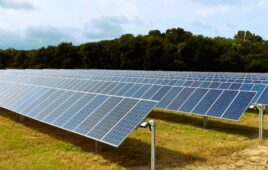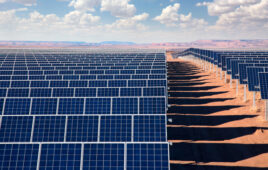Article By Isaac Freed, sales representative at terrafix Groundwork Corporation
Tracking technologies allow solar arrays to follow the sun, optimizing the sun’s angle of incidence, and maximizing solar power production. Single-axis trackers often have a north-south axis and track the sun each day from sunrise to sunset. It is said that such trackers offer an increased power output of 20 to 25% over fixed-tilt solar arrays, while adding about 5 to 10% to system cost. You will see single-axis trackers deployed where there is strong sunshine early and late in the day, where power purchase agreements offer higher rates for power produced during daylight hours and where land is inexpensive.
Photo courtesy of terrafix Groundwork
Dual-axis trackers also follow the daily east-west sun path. Additionally, they adjust their tilt-angle towards the equator, to follow the sun throughout the year. In California, which ranges from 32 to 42 degrees North latitude, the sun’s angle above the horizon at solar noon varies from 24 degrees on the winter solstice to 81 degrees on the summer solstice. By tracking this seasonal change of the sun’s angle above the horizon, in addition to the sun’s daily movement across the sky, dual-axis trackers can increase array output by as much as 40%, while adding about 10 to 15% to system cost.
An important consideration for trackers is Ground Coverage Ratio (GCR), which measures the portion of a field that is covered with solar panels. A fixed-tilt array might have a 50% GCR, 300 kW per acre nameplate rating, and produce 500 MWh per acre per year. In contrast, a single-axis tracker might have a 33% GCR, 200 kW per acre nameplate rating, and produce 400 MWh per acre per year. A dual-axis tracker might only fit 135 kW per acre, having a GCR of less than 25%, and 300 MWh per acre per year of production. Thus, where land is in short supply or very expensive, trackers do not make sense. However, sometimes trackers are required. Such is the case for Concentrating Photovoltaics (CPV), which rely on Direct Normal Irradiance (perpendicular sunlight), and thus require precise dual-axis tracking. In contrast, flat plate collectors also gather Diffuse Horizontal Irradiance, so are most often seen at fixed tilts.
Some sharp-penciled folks suggest that, if production can be increased by over 20%, while incurring a cost increase of less than 10%, then trackers make sense. More conservative builders believe that the problem with trackers is that they move. Mechanical parts are prone to failure, and when a tracker stalls facing away from the sun, money is lost. However, tracker manufacturers assure that with proper installation and minimal maintenance, system reliability is ensured. Market acceptance of trackers is indicated by the proliferation of tracker technologies available. For instance, Array Technologies, a leading single-axis tracker manufacturer, boasts over a gigawatt of installed product.
Investors and developers of solar farms seek to lower their Levelized Cost of Energy (LCOE), which trackers can achieve when they function properly every day for twenty years. Some of the largest investors and developers in the solar space are comfortable using trackers, mitigating their risk through third party reliability reports and product track records. Considerations in the reliability of a tracker are the quality of materials used, the drive mechanism, the ease of installation, maintenance and repair, the financial stability of the tracker manufacturer and the results of real-world product application.
The solar industry is driven by investment capital, which seeks to minimize risk and maximize reward. The conservative approach is to avoid trackers, which may save a hair on O&M costs, and eliminates one of the riskier parts of the investment – literally, the moving part. Yet choosing a proven and reliable tracking technology can increase investor returns with minimal added risk, and as the market demonstrates, trackers are helping to lower the cost of solar power.
terrafix Groundwork Corporation
www.terrafix.com




Tell Us What You Think!